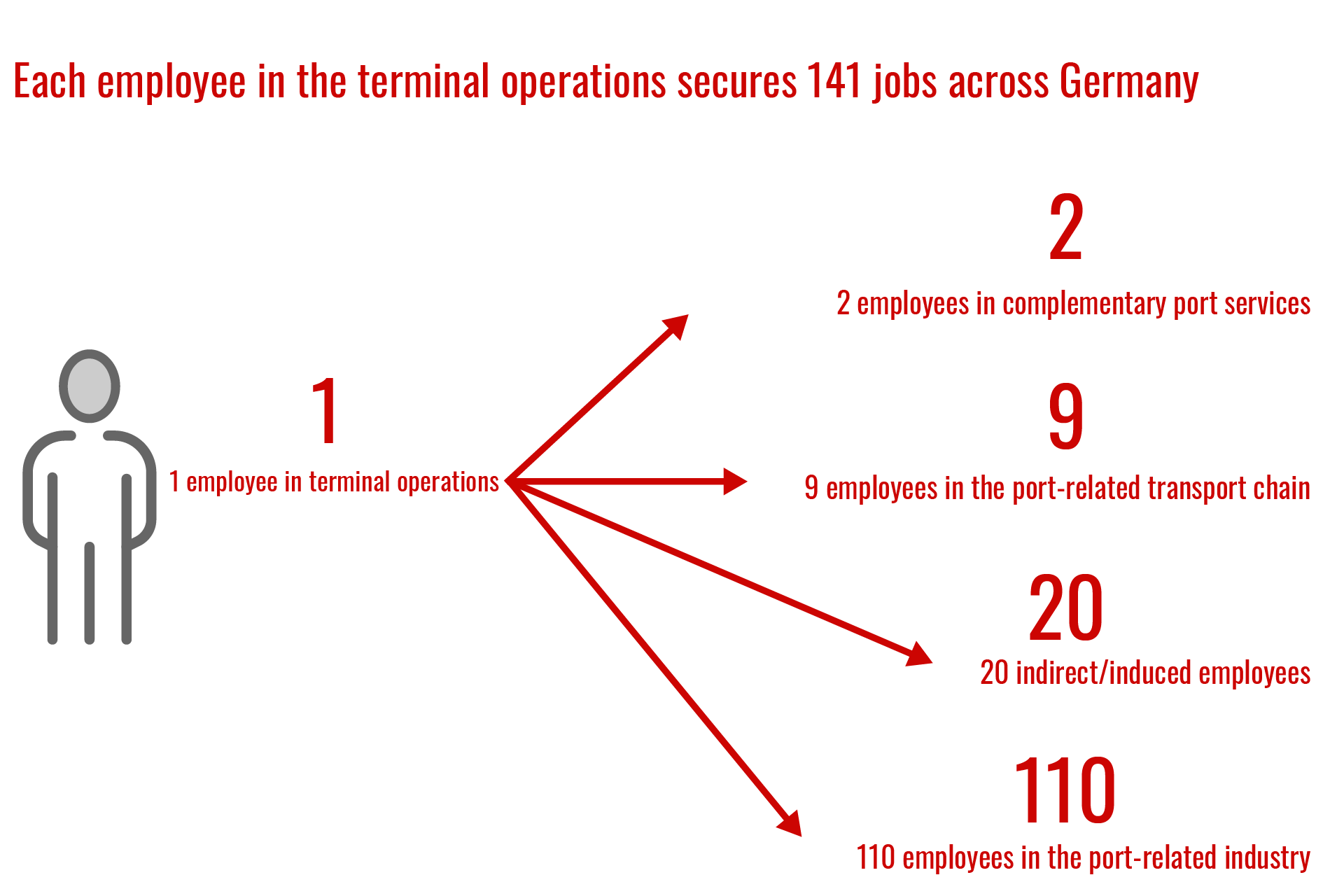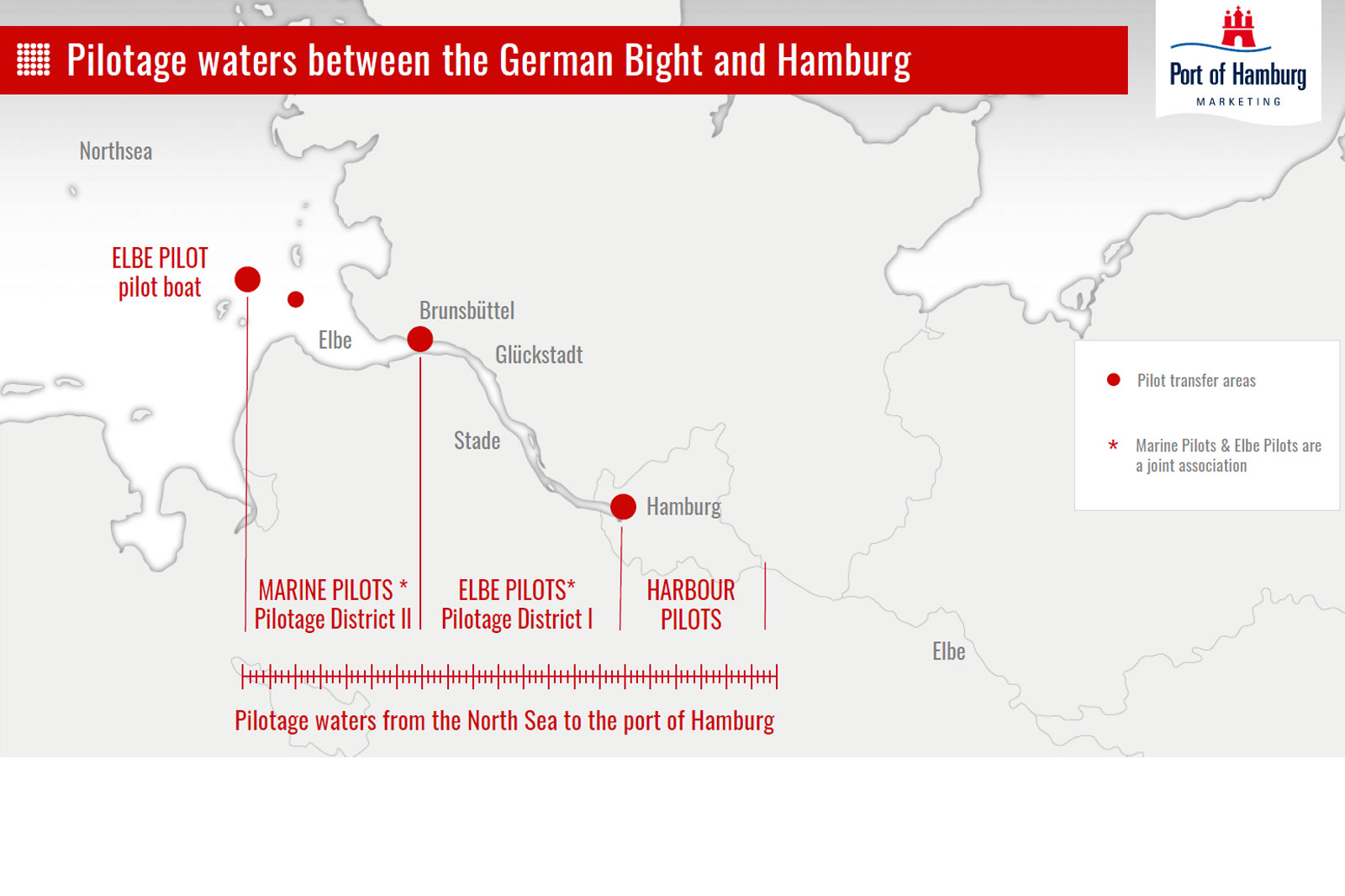News
17 Aug 2022
Port of Hamburg boosts container throughput market…
- Upward trend for container throughput - Growth in transhipment - Downturn in bulk cargo handling - Double-digit growth in conventional cargoes

The mammoth task to adjust the fairway of the Lower and Outer Elbe has been completed. Since the end of January 2022, ships arriving and departing can use the new permitted fairway depth of up to 16.10 meters. This is a major advantage for the competitive capability of the Port of Hamburg.
The Elbe is a tidal river, the tides determine the possible draughts of ships. Depending on the size and type of ship, different maximum drafts apply for tide-independent and tide-dependent navigation. Depending on the tide, a distinction is also made between outbound and inbound navigation.
For a matter of comparability following vessel size is used, a container ship with a length of 350 meters and a width of 46 meters forms basis of assessment and comparability. Such vessel can now use a draft of up to 13.80 meters regardless of tide. Before the adjustment, it was only 12.70 meters. Coming in on the tide, even 16.10 meters are possible (before: 15.10 meters). Outgoing, 14.80 meters are still possible. Here, it was previously 13.80 meters.
The largest container ships in the world, so called megamax ships, with a width of up to 62.50 meters and a length of 400 meters can enter the port with a draught of up to 13.10 meters, regardless of the tide. Before the adjustment, this was limited to 11.40 meters. Departing tide-dependent, a draught of 14.10 meters is permitted (previously: 12.20 meters). Incoming a draught of 15.40 meters is now possible. Previously, this was limited to 13.60 meters.
If Megamax ships use the maximum draught permitted, per call up to 2440 TEU or up to 35,000 metric tons can be transported in addition in each direction compared with the conditions set out before the fairway was adjusted.
Compared with the situation before the navigational fairway was deepened, shipping will heavily benefit from the draft increase of between 1.00 and 1.90 meters - depending on the ship's dimensions - both inbound and outbound.

At least as important as the deepening is the widening of the navigational fairway in certain areas. The growing number of large ships shows: Restrictions on the width of the ships pose a general nautical challenge. This will be mitigated by the fairway adjustment. Certain areas are widened enabling large ships passing each other on their in- and outbound voyage. We call this area a passing box. For example:
Between Wedel and Blankenese, an eight-kilometer-long encounter box with a width of 385 meters was created. Further downstream from Wedel the fairway was widened from 300 to 320 meters. In practice, it turns out that this particular encounter box facilitates the ships passing each other either on their way to the port of Hamburg or on their outbound voyage.

The new encounter box between Blankenese and Wedel allows ships with a combined added width of up to 104 meters to pass each other. Further downstream from Wedel the new widening of the fairway also has advantages. Here, ships with an added width of 92 meters can now pass each other safely.
The flow of ship’s traffic from the North Sea to the berth can be organized and optimized more flexible by the HPA's Nautical Center, the federal government's district centers and the Hamburg Vessel Coordination Center (HVCC). Potential conflict situations on the Elbe and in the Hamburg port area can thus be identified at an early stage and resolved in good time.
The control of scheduled "just-in-time" arrivals of the ships also makes it possible to save large quantities of fuel and thus helps to reduce emissions.

The fairway adjustment also ensures better planning at the terminals. The departure windows have been recalculated and optimized for all ships. Even before the clearance of the new fairway channel was granted, terminal operators had already prepared and adapted their container bridges to the Megamax ships with a capacity of than 20,000 TEU and more. In some cases the new bridges which were installed to load and unload container have an outreach to stretch across up to 26 rows of containers side by side.

The environmental balance of maritime transport is generally much more favorable than that of land transport, especially in comparison to road transport. With new, large and environmentally friendly ships, energy consumption as well as pollutant emissions per transported ton or unit of cargo can be reduced.
The advantage of transporting goods by ship is the high transport performance combined with low consumption of resources. Sea transport of containers is more economical and environmentally friendly the more units are transported per ship - unit costs and environmental impact are correspondingly lower.

Through the fairway adjustment, the passage for the latest and most climate-friendly generation of large ships has been cleared resulting in economical consumption, significantly reduced pollution and CO2 emissions, and an even better energy balance per container transported. For the Port of Hamburg, this advantage is particularly effective. Hamburg is located 145 kilometers from the mouth of the river, deep inland. This location reached by ship makes it possible to reduce land transports, which are significantly more harmful to the climate, during the pre- and onward carriage of goods. The expansion of the Elbe federal waterway thus relieves road traffic and protects the environment.

Shipping companies plan their fleets for the long term and with a global perspective. Investments in new large ships are made when they can be deployed on as many traffic lines as possible with the largest possible cargo volume. When selecting ports of call, important factors for shipowners include having the largest possible cargo volumes, high-performance handling facilities, a dense network of hinterland transport links and good accessable nautical conditions.
Until now, the depth restrictions have been an economic burden for shipping companies, which have had to forego cargo to and from Hamburg. With the successful implementation of the fairway adjustment, Hamburg now offers shipping companies significantly improved nautical conditions and continues to expand its position as one of Europe's leading seaports.

The ship orders of the shipping companies show that in particular the share of container ships with maximum design drafts of >14.50 meters is increasing rapidly. This development is confirmed by the increasing number of calls of corresponding large container ships in the Port of Hamburg. Since the first calls in 2015, the number of units with more than 18,000 TEU slot capacity in the port has multiplied. In 2021, 221 calls by large container ships in the 18,000 to 23,000+ TEU size segment were counted in Hamburg alone.

The Port of Hamburg is already well equipped to handle exceptionally large vessels (ships longer than 330 meters and/or wider than 45 meters) and is constantly adapting its infrastructure to meet market requirements. For example, the Port of Hamburg has four high-performance container terminals, which are among the most modern in the world and which can handle the largest container ships.
In May 2020, five more container gantry cranes of the latest generation were commissioned at HHLA Container Terminal Burchardkai (CTB). CTB is Hamburg's largest handling facility for containers. HHLA now has a total of 13 of such gantry cranes at CTB. At two berts CTB can thus handle ships with a capacity of 24,000 TEU. The cranes have an outreach across 26 rows of container side by side.
Also at HHLA Container Terminal Tollerort (CTT), a total of five container gantry cranes are operating to handle the latest generation of large ships with a capacity of 20,000 TEU and more.
Another example of the improvement in call conditions for large ships in the Port of Hamburg is the expansion of the waterside access to HHLA Container Terminal Tollerort. This has extended the usable tidal time window for the arrival and departure of large ships. There are also plans to expand the turning circle for access to Waltershofer Hafen location of the CTB and Eurogate container terminals from 480 to 600 meters.

Globalization continues to determine world trade. For Hamburg, the greatest growth potential lies not only in East Asian trade but also in traffic with North and South America. Major trades are now and will continue to be served by large container ships, which are efficiently handled at high-performance transshipment terminals in Hamburg. Germany's economy needs an efficient port, which is an important element in the 24/7 service for many global supply chains.
Approximately 607,000 jobs indirectly depend on the Port of Hamburg nationwide. According to a study by the Hamburg Port Authority, these port-related employees generated a gross value added to 50.8 billion euros nationwide. The fairway adjustment facilitates the accessibility of the port and is thus also a contribution to securing the future of Hamburg as a port and logistics location.

The Port of Hamburg is the most important job engine in northern Germany. Due to the port's close links with the distribution centers of the logistics industry, its employment impact radiates throughout Germany. In addition to the two major handling companies HHLA and Eurogate, several hundred individual companies offer services in the fields of handling, storage and transport in the Port of Hamburg. In addition, there are numerous companies based in the port or in the vicinity of the port, as well as many service providers for all aspects of marine industry. Their business success depends to a large extent on the port. A competitive port is good for the economy and secures employment. The port is internationally positioned, offers sustainable jobs and ensures stable tax revenues in Hamburg and the region.

The successful widening and deepening of the Elbe navigation channel is a necessary measure to maintain the competitiveness of the Port of Hamburg. In combination with the investments in large bridges and automated storage technology already made by Hamburger Hafen und Logistik AG (HHLA) on its facilities, the adjustment now implemented makes it possible to handle ever larger container ships safely and reliably. This creates maximum plannability in inflow management for both HHLA and our customers.

We are delighted that after years of intensive planning, the fairway adjustment megaproject has been completed. Above all, we would like to thank our partners and customers, who have repeatedly assured us of their confidence in the Port of Hamburg in many personal discussions. The figures show that the market has responded well to the first release stage of the fairway adjustment. From May to December 2021, the Port of Hamburg was called by 2,377 container ships. In 666 of these calls, the ships had a design draught of more than 13.80 meters. And 96 of these ships had a draft that was not accessable before partial clearance of the fairway adjustment. With the final draught clearance, we now expect the numbers of large vessels to further increase.

For Germany's largest port, this means better call conditions, enabling shipping companies to bring more cargo to Hamburg.

For shipping and our port customers from the business sector, the easier access to Germany's largest universal port also brings the advantage of routing more cargo via Hamburg. On the land side, the environmentally friendly railroad takes over the main share in the transport of goods and connects the inland market regions with the port quickly and reliably. With efficient transport routes, smart logistics solutions and the increasing use of low-emission energy sources and technology, we are on the right course toward sustainable growth. The Port of Hamburg also secures around 607,000 jobs in Germany alone.

With the final clearance, significantly more draught is now available to shipping. In addition to the nautical advantages, the increased depths also bring added economic and ecological value. This is because more depth means better utilization of the ships and thus leads to fewer emissions per ton transported.

The planning for the fairway adjustment and the integrated river engineering concept largely reduce the impact on nature and the environment. In addition, extensive ecological compensation measures are being implemented (total expenditure approx. 80 million euros). This involves renaturalizing areas that have been reshaped by man in past decades. In the opinion of the federal government and Hamburg, this will fully compensate for the adverse effects on nature and the environment caused by the adjustment of the fairway. And the EU Commission, after examining all the information, also came to the conclusion that the impairments will be fully compensated, and in some cases even overcompensated, by the planned compensatory measures.
Independent of these project-related compensatory measures, the Habitat Elbe Foundation is making another significant contribution to the sustainable development of the tidal river Elbe as the lifeline to the Hamburg metropolitan region. In the environmental foundation established in 2010, the city, port and nature conservation authorities work together to improve the ecological condition of the Elbe. The foundation is financed by a starting capital of ten million euros and an annual grant of five percent of the port fees collected by the Hamburg Port Authority (HPA). Thus, the foundation's income is directly linked to the development of the port.

It is undisputed that large ships have an unbeatable carbon footprint compared to trucks and trains. But all this can only work if the waterways are clear for navigation. To this end, in Hamburg, as in most ports around the world, the harbor basins and shipping channels must be regularly cleared of sediment. For your understanding, the Elbe is a natural system that constantly carries tons of sediment. Sediments reach Hamburg from two directions: incoming with the tide from the direction of the North Sea, and outgoing with the headwater from the Elbe catchment area. These sediments are deposited in calm areas with slow flow of the tidal river Elbe, such as in the Port of Hamburg and its basins.
However, in order to ensure that the target depth of the fairway is maintained throughout and that ships continue to reach their destination, the Hamburg Port Authority (HPA) and the Federal Waterways and Shipping Administration (WSV) have to move several million cubic meters of sediment every year. The majority of the material is harmless and can be returned to the water system at a suitable location. A small part of the sediment from the upper reaches has bound too many pollutants on its way to Hamburg and must be treated and safely disposed of on land.
Together, the two partners HPA and WSV have initiated a dialog process with all stakeholders along the river, this includes the neighboring countries, districts and municipalities, with fisheries, tourism and water sports along the Lower Elbe as well as with environmental and business associations for a new sediment management: The so called „Dialogforum Strombau- und Sedimentmanagement Tideelbe“.
The jointly developed results form the basis for a more sustainable approach to sediment management. The aim is to ensure that less sediment is produced and its impact is reduced even further. In December 2016, the go-ahead was given for the "Forum Tideelbe" - an institution whose aim is to drive forward the sustainable development of the tidal river Elbe together with the various stakeholders.
The Tidal Elbe Forum builds on the solution approaches of the previous dialog forum and envisages the implementation of projects to make the Lower Elbe more natural and thereby reduce the upstream sediment transport towards Hamburg.

For years, the number of so-called exceptionally large vessels calling at the Port of Hamburg has been increasing. This includes not only container ships, but also bulkers and cruise ships. These vessels are more than 330 meters long and/or over 45 meters wide. With the Nautical Terminal Coordination Center, the Port of Hamburg has an institution that takes care of the central operational coordination of large ship destined for Hamburg - long before the ship arrive on the Elbe. In some cases, ships are accompanied already from Gibraltar on their way to the port.
NTC's tasks include the cross-terminal operational coordination of pre-planning, inflow control and departure planning for large ships in the Port of Hamburg. The operational overview created in this way is coordinated by the NTC as a central interface around the clock with the Nautical Headquarters in Hamburg and the Elbe pilots.
Communication channels are bundled via the NTK and interactions of decisions concerning the handling of large ships are identified at an early stage. In this way, conflict situations are already identified and eliminated as far as possible during the approach to the port area. The aim is to optimize traffic management on the Elbe and reduce the workload on the Nautical Control Center.
